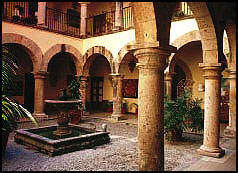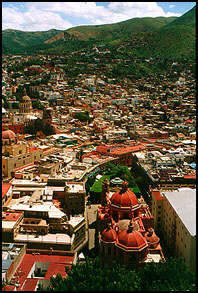 TOURISM: THE NEGLECTED SECTOR REDISCOVERED TOURISM: THE NEGLECTED SECTOR REDISCOVERED |
Mexico's tourism promotion budget last year came to just US$20 million, a relatively small sum compared to the budgets of other Latin American countries. Oscar Espinosa, currently charged with embezzling more than US$45 million when he was mayor of Mexico City (1995-97), stepped down as Tourism Secretary in August and fled the country. The tourism industry, needless to say, has suffered.
Despite years of administrative neglect and meager budgets, the tourism industry has nonetheless found a way to become the seventh-most popular tourist destination in the world. More than 22 million sightseers visited Mexico last year, and in 2000, tourism is expected to generate US$8 billion. As a breadWorld Investment News Ltdr of foreign currency for Mexico, the tourism industry ranks third, only just behind manufactured goods and oil exports.
Most within the tourism industry seem optimistic that Fox's welcome arrival and Oscar Espinosa's harried departure will serve as the turning point for the tourism industry. Perhaps evidence of changes-to-come can be found in the recently established Tourist Promotion Board of Mexico. While the Board still has no budget for Asia, it is now working with a US$55 million budget, funded in part by a recently enacted visitor's fee of US$15.
The new Tourist Promotion Board, coupled with the government's increased awareness of the importance of tourism revenue, is creating an advantageous opening in the sector for more investment. Mexico is a nation blessed with two winding and pristine coastlines, dense jungles, meandering canyons, pine-covered mountains, quaint villages with narrow cobblestone streets, and countless archaeological sites. Considering Mexico's natural beauty and what appears will be an unprecedented interest in tourism, most would agree that the industry is certain to prosper.

For years now, the tourist industry and the government have known that, in order for Mexico compete for tourists, it would have to put its administrative house in order, step up promotion, and develop a tourist infrastructure that provided the services demanded by the international traveler.
"It's a lot easier to stick bricks together in harmony and beauty than it is to provide professional service," says Francisco Martinez Martinez, president of Quinta Real Hotels. "The hotel industry is a business of services, not bricks. That's where we still have a lot of work to do."
Acapulco, once the crown jewel of the Mexican Riviera, is a good example of the waning services and dwindling popularity of many popular resort towns. Upstaged by the trendier resorts of Cancun and Puerto Vallarta, tourist industry promoters in Acapulco have been forced to rethink the future of their city amid an internationally competitive market. Zedillo recently kicked off a "Relaunching Acapulco" campaign as the centerpiece of efforts to revive Acapulco as a major tourist destination.
The other traditional tourist spots in Mexico include Cabo San Lucas and Santa Rosalia along the Baja California Peninsula, and the cities of Mazatlan, Zihautanejo, Pie de la Cuesta, and Puerto Escondido along the Pacific Coast. Out on the Yucatan Peninsula, one can find coral reefs, Maya-Toltec ruins, and a laid-back lifestyle at Cancun and Playa del Carmen. The more adventurous traveler will enjoy the spectacular mountain scenery of Copper Canyon or the picturesque old mining town of Taxco just south of Mexico City. In the South, the beautiful colonial city of Oaxaca and the handsome highland town of San Cristobal de Las Casas in Chiapas are increasingly popular tourist destinations.

While Mexico is making a great effort to improve services across the board, the most important endeavors may be the development and promotion of other forms of tourism beyond the traditional sun-and-sand brand of tourism one usually finds in coastal towns. Each state in Mexico is famed for its own traditional cuisine, music, folklore, handicrafts, and traditional dress.
One of Mexico's up-and-coming tourism states happens
to be Baja California. Baja California has made
numerous adjustments in its tourism policy to solidify
the sector and attract more investment. Under the
guidance of State Tourism Secretary Juan
B. Tintos Funcke, the state hotel room tax was
reactivated, a maneuver that in just three years
has generated five times more resources for state
tourism promotion. They've also been able to increase
the number of events held in the state from 100
to 250. This is a state that already boasts such
internationally recognized events as the Baja 1,000
and Baja 500 off-road races. |
In particular, the proposed Escalera Nautica project in Baja California and Baja California Sur presents an interesting opportunity for investors. The project would finance a canal allowing yachts to cross the Baja California Peninsula.
"My immediate goal," says Tintos Funcke, "is to leave the Escalera Nautica (project) in such an (advanced stage) that, hopefully next year, we'll have the ground-breaking from Santa Rosalita to Bahia Los Angeles."
The state of Zacatecas presents another great example. Taking exceptional pride in the beautiful cities of Ciudad de Zacatecas and Real de Catorce-where a Hollywood feature movie with Brad Pitt was recently filmed-Zacatecas has sought to promote state tourism while preserving its traditional, colonial charm.
"It is a very singular kind of tourism that visits Zacatecas because it's a very tranquil city with great museums and grand attractions," says Zacatecas Governor Ricardo Monreal Avila. "The city itself, the best-preserved colonial city in the country, makes tourism very attractive."
The state of Morelos, known in tourist circles mostly for the city of Cuernavaca, which has more Spanish-language schools than any other city in Mexico, hopes that investment will help them develop their tourism industry. From 16th-century convents to well-preserved archaeological sites to world-class cuisine, Morelos "has an infinite number of corners to take advantage of," says state Governor Sergio Estrada Cajigal.
Guanajuato, Fox's home state, is also interested in attracting investment to the tourism sector, especially in the renovation of former haciendas, or ranches, into tourism centers. The state also has 10 towns that have been declared historical centers and thus targeted for development.

"Before, as far as the world was concerned, Guanajuato did not exist," says state Gov. Ramon Martin Huerta. "Now, we are on the map at least. We have developed the tourism and hotel industries, but there are still many more opportunities for investment."
And perhaps one of the states with the most potential for tourism investment is Jalisco.
"Jalisco is one of the most varied states in Mexico," says Pablo Gerber Stump, Jalisco Minister of Tourism. "We have the second-most important tourist destination in the country: Puerto Vallarta. There you can find excellent hotels and resorts, golf courses, beautiful marinas, the best restaurants, everything that will make you enjoy your stay."
Indeed, Jalisco represents a veritable wellspring of opportunity for investors. For example, the Jalisco Tourism Secretariat is looking to develop the shores of Lake Chapala, a popular expatriate retirement community, with cabins, hotels, and restaurants. The state also enjoys more than 200 kilometers of pristine beaches without any tourist development whatsoever.

"It will take many years to make those areas profitable," says Stump. "We know the potential; nevertheless, it will take time. Many investors are interested."
Jalisco has also taken pains to generate more Asian interest in the state, though without too much success.
"This administration has visited Asia every year since its beginning," says Stump. "We have worked especially with Asian airlines and travel agencies, but it is not that easy because of the distances."
But whether they come from the other side of the globe or from across the northern border, tourists are flocking to Mexico.
"Mexico should be getting around 40 million visitors by 2012-2020,"says Javier Vega Camargo, general manager for the Tourism Promotion Board. "This means that in 15 to 20 years, we are going to double the number of tourists we receive." |

